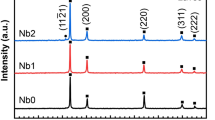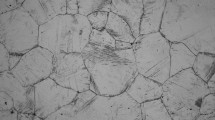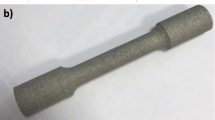Abstract
Metals are prone to oxidation in high-temperature oxygen-containing environments, resulting in oxidative corrosion. This study proposes a fully coupled chemomechanical model and further develops a finite element method (FEM) to characterize the high-temperature oxidation process of metals. Then, we perform finite element analyses for surface oxidation of FeCrAlY alloy to verify the proposed chemomechanical model. Good agreements of FEM results with experimental observations suggest that the model can be used to predict the surface oxidation of metals. The numerical results also reveal the two-way coupling effects between chemical processes and mechanical stress. Furthermore, it is found that compressive stress could inhibit diffusion and chemical reaction in the oxide layer. In contrast, the stress distribution of the oxide layer can also be significantly influenced by compositional strain induced by the concentration change of diffusive species and growth strain induced by chemical reactions. In addition, we find that the barrier effect of alumina on diffusion can significantly slow down the growth of the oxide layer. This study provides an effective model for chemomechanical phenomena and may also shed light on the design of alloys in a request of resistance to oxidative corrosion.









Similar content being viewed by others
References
Abraimov, N.V., Samoilenko, V.M.: Choice of materials and coatings for high-speed aircrafts. Russ. Metall. Metall. 2020, 667–675 (2020). https://doi.org/10.1134/s0036029520060026
Akande, I.G., Oluwole, O.O., Fayomi, O.S.I., Odunlami, O.A.: Overview of mechanical, microstructural, oxidation properties and high-temperature applications of superalloys. Mater. Today Proc. 43, 2222–2231 (2021). https://doi.org/10.1016/j.matpr.2020.12.523
Tolpygo, V., Clarke, D.: Competition between stress generation and relaxation during oxidation of an Fe–Cr–Al–Y alloy. Oxid. Met. 49(1), 187–212 (1998). https://doi.org/10.1023/a:1018828619028
Tolpygo, V., Dryden, J., Clarke, D.: Determination of the growth stress and strain in α-Al2O3 scales during the oxidation of Fe–22Cr–4.8Al–0.3Y alloy. Acta Mater. 46(3), 927–937 (1998). https://doi.org/10.1016/S1359-6454(97)00306-6
Loeffel, K., Anand, L.: A chemo-thermo-mechanically coupled theory for elastic–viscoplastic deformation, diffusion, and volumetric swelling due to a chemical reaction. Int. J. Plast. 27, 1409–1431 (2011). https://doi.org/10.1016/j.ijplas.2011.04.001
Hu, S., Shen, S.: Non-equilibrium thermodynamics and variational principles for fully coupled thermal–mechanical–chemical processes. Acta Mech. 224, 2895–2910 (2013). https://doi.org/10.1007/s00707-013-0907-1
Yu, P., Shen, S.: A fully coupled theory and variational principle for thermal-electrical-chemical-mechanical processes. J. Appl. Mech. Trans. ASME (2014). https://doi.org/10.1115/1.4028529
Zhang, X., Zhong, Z.: A coupled theory for chemically active and deformable solids with mass diffusion and heat conduction. J. Mech. Phys. Solids 107, 49–75 (2017). https://doi.org/10.1016/j.jmps.2017.06.013
Sofronis, P.: The influence of mobility of dissolved hydrogen on the elastic response of a metal. J. Mech. Phys. Solids 43, 1385–1407 (1995). https://doi.org/10.1016/0022-5096(95)00037-J
Philibert, J.: Atom movements: diffusion and mass transport in solids. Les Editions de Physique Les Ulis (1991)
Raceanu, L., Optasanu, V., Montesin, T., Montay, G., François, M.: Shot-peening of pre-oxidized plates of zirconium: influence of residual stress on oxidation. Oxid. Met. 79, 135–145 (2013). https://doi.org/10.1007/s11085-012-9336-0
Pilling, N.B.: The oxidation of metals at high temperature. J. Inst. Met. 29, 529–582 (1923)
Rhines, F.N., Wolf, J.S.: The role of oxide microstructure and growth stresses in the high-temperature scaling of nickel. Metall. Trans. 1, 1701–1710 (1970)
Clarke, D.R.: The lateral growth strain accompanying the formation of a thermally grown oxide. Acta Mater. 51, 1393–1407 (2003). https://doi.org/10.1016/s1359-6454(02)00532-3
Maharjan, S., Zhang, X.C., Wang, Z.D.: Analytical modeling of stress and strain of symmetrically oxidized metal. J. Appl. Phys. (2012). https://doi.org/10.1063/1.4740048
Dong, X., Feng, X., Hwang, K.-C.: Oxidation stress evolution and relaxation of oxide film/metal substrate system. J. Appl. Phys. (2012). https://doi.org/10.1063/1.4736934
Grosseau-Poussard, J.L., Panicaud, B., Ben Afia, S.: Modelling of stresses evolution in growing thermal oxides on metals. A methodology to identify the corresponding mechanical parameters. Comput. Mater. Sci. 71, 47–55 (2013). https://doi.org/10.1016/j.commatsci.2013.01.013
Zumpicchiat, G., Pascal, S., Tupin, M., Berdin-Méric, C.: Finite element modelling of the oxidation kinetics of Zircaloy-4 with a controlled metal-oxide interface and the influence of growth stress. Corros. Sci. 100, 209–221 (2015). https://doi.org/10.1016/j.corsci.2015.07.024
Dong, X., Fang, X., Feng, X., Hwang, K.-C., Cinibulk, M.: Diffusion and stress coupling effect during oxidation at high temperature. J. Am. Ceram. Soc. 96, 44–46 (2013). https://doi.org/10.1111/jace.12105
Dong, X., Feng, X., Hwang, K.-C.: Stress–diffusion interaction during oxidation at high temperature. Chem. Phys. Lett. 614, 95–98 (2014). https://doi.org/10.1016/j.cplett.2014.09.011
Larche, F., Cahn, J.: Linear theory of thermochemical equilibrium of solids under stress. Acta Metall. 21, 1051–1063 (1973). https://doi.org/10.1016/0001-6160(73)90021-7
Larcht’e, F.C., Cahn, J.L.: The effect of self-stress on diffusion in solids. Acta Metall. 30, 1835–1845 (1982)
Larché, F.C., Cahn, J.W.: Overview no. 41 the interactions of composition and stress in crystalline solids. Acta Metall. 33, 331–357 (1985)
Evans, H.E.: Stress effects in high temperature oxidation of metals. Int. Mater. Rev. 40, 1–40 (1995)
Krishnamurthy, R., Srolovitz, D.J.: Stress distributions in growing oxide films. Acta Mater. 51, 2171–2190 (2003). https://doi.org/10.1016/s1359-6454(03)00009-0
Cui, Z., Gao, F., Qu, J.: Interface-reaction controlled diffusion in binary solids with applications to lithiation of silicon in lithium-ion batteries. J. Mech. Phys. Solids 61, 293–310 (2013). https://doi.org/10.1016/j.jmps.2012.11.001
Haftbaradaran, H., Qu, J.: Two-dimensional chemo-elasticity under chemical equilibrium. Int. J. Solids Struct. 56–57, 126–135 (2015). https://doi.org/10.1016/j.ijsolstr.2014.11.025
Chen, L., Yueming, L.: A coupled mechanical-chemical model for reflecting the influence of stress on oxidation reactions in thermal barrier coating. J. Appl. Phys. 10(1063/1), 5019848 (2018)
Zhou, H., Qu, J., Cherkaoui, M.: Stress–oxidation interaction in selective oxidation of Cr–Fe alloys. Mech. Mater. 42, 63–71 (2010). https://doi.org/10.1016/j.mechmat.2009.09.007
Wang, H., Suo, Y., Shen, S.: Reaction–diffusion–stress coupling effect in inelastic oxide scale during oxidation. Oxid. Met. 83, 507–519 (2015). https://doi.org/10.1007/s11085-015-9531-x
Suo, Y., Shen, S.: General approach on chemistry and stress coupling effects during oxidation. J. Appl. Phy. (2013). https://doi.org/10.1063/1.4826530
Freidin, A.B., Vilchevskaya, E.N., Korolev, I.K.: Stress-assist chemical reactions front propagation in deformable solids. Int. J. Eng. Sci. 83, 57–75 (2014). https://doi.org/10.1016/j.ijengsci.2014.03.008
Chen, J., Wang, H., Liew, K.M., Shen, S.: A fully coupled chemomechanical formulation with chemical reaction implemented by finite element method. J. Appl. Mech. (2019). https://doi.org/10.1115/1.4042431
Shen, S.: Transient continuum mechanics and chemomechanics. J. Appl. Mech. 89, 061004 (2022). https://doi.org/10.1115/1.4054061
Suo, Y., Shen, S.: Analytical solution for one-dimensional coupled non-Fick diffusion and mechanics. Arch. Appl. Mech. 83, 397–411 (2012). https://doi.org/10.1007/s00419-012-0687-4
Yang, Q., Tian, H., Qin, Q.: Analytical solutions for a one-dimensional chemomechanical coupling problem. Acta Mech. Solida Sin. 27, 137–145 (2014). https://doi.org/10.1016/s0894-9166(14)60024-0
Panicaud, B., Grosseau-Poussard, J.L., Dinhut, J.F.: General approach on the growth strain versus viscoplastic relaxation during oxidation of metals. Comput. Mater. Sci. 42, 286–294 (2008). https://doi.org/10.1016/j.commatsci.2007.07.017
Krishnamurthy, R., Sheldon, B.W.: Stresses due to oxygen potential gradients in non-stoichiometric oxides. Acta Mater. 52, 1807–1822 (2004). https://doi.org/10.1016/j.actamat.2003.12.020
Zhao, Y., Ai, S., Fang, D.: Elasto-plastic phase field modelling of oxidation of zirconium alloys. Int. J. Solids Struct. 134, 30–42 (2018). https://doi.org/10.1016/j.ijsolstr.2017.10.033
Shen, Q., Li, S.Z., Yang, L., Zhou, Y.C., Wei, Y.G., Yuan, T.: Coupled mechanical-oxidation modeling during oxidation of thermal barrier coatings. Comput. Mater. Sci. 154, 538–546 (2018). https://doi.org/10.1016/j.commatsci.2018.08.017
Wang, Z., Grosseau-Poussard, J.-L., Panicaud, B., Labergère, C.: Finite element analysis of stress evolution during the high temperature oxidation of Ni30Cr+ Cr2O3 systems. J. Alloy. Compd. 904, 164094 (2022). https://doi.org/10.1016/j.jallcom.2022.164094
Parise, M., Sicardy, O., Cailletaud, G.: Modelling of the mechanical behavior of the metal–oxide system during Zr alloy oxidation. J. Nucl. Mater. 256, 35–46 (1998). https://doi.org/10.1016/S0022-3115(98)00045-2
Huntz, A.M., Amiri, G.C., Evans, H.E., Cailletaud, G.: Comparison of Oxidation-growth stresses in NiO film measured by deflection and calculated using creep analysis or finite-element modeling. Oxid. Met. 57, 499–521 (2002). https://doi.org/10.1023/A:1015352421890
Loeffel, K., Anand, L., Gasem, Z.M.: On modeling the oxidation of high-temperature alloys. Acta Mater. 61, 399–424 (2013). https://doi.org/10.1016/j.actamat.2012.07.067
Birks, N., Meier, G.H., Pettit, F.S.: Introduction to the high temperature oxidation of metals. Cambridge University Press (2006)
El Kadiri, H., Horstemeyer, M.F., Bammann, D.J.: A theory for stress-driven interfacial damage upon cationic-selective oxidation of alloys. J. Mech. Phys. Solids 56, 3392–3415 (2008). https://doi.org/10.1016/j.jmps.2008.09.001
Denton, A.R., Ashcroft, N.W.: Vegard’s law. Phys. Rev. A. 43, 3161–3164 (1991). https://doi.org/10.1103/PhysRevA.43.3161
Swaminathan, N., Qu, J., Sun, Y.: An electrochemomechanical theory of defects in ionic solids I. Theory. Philos. Mag. 87, 1705–1721 (2007). https://doi.org/10.1080/14786430601102973
Coleman, B.D., Gurtin, M.E.: Thermodynamics with internal state variables. J. Chem. Phys. 47, 597–613 (1967). https://doi.org/10.1063/1.1711937
Chester, S.A., Di Leo, C.V., Anand, L.: A finite element implementation of a coupled diffusion-deformation theory for elastomeric gels. Int. J. Solids Struct. 52, 1–18 (2015). https://doi.org/10.1016/j.ijsolstr.2014.08.015
Di Leo, C.V., Anand, L.: Hydrogen in metals: a coupled theory for species diffusion and large elastic–plastic deformations. Int. J. Plast. 43, 42–69 (2013). https://doi.org/10.1016/j.ijplas.2012.11.005
Bouklas, N., Landis, C.M., Huang, R.: A nonlinear, transient finite element method for coupled solvent diffusion and large deformation of hydrogels. J. Mech. Phys. Solids 79, 21–43 (2015). https://doi.org/10.1016/j.jmps.2015.03.004
Busso, E.P., Lin, J., Sakurai, S.: A mechanistic study of oxidation-induced degradation in a plasma-sprayed thermal barrier coating system.: Part II: Life prediction model. Acta Mater. 49, 1529–1536 (2001)
Quested, P.N., Brooks, R.F., Chapman, L., Morrell, R., Youssef, Y., Mills, K.C.: Measurement and estimation of thermophysical properties of nickel based superalloys. Mater. Sci. Technol. 25, 154–162 (2013). https://doi.org/10.1179/174328408x361454
Favergeon, J., Montesin, T., Bertrand, G.: Mechano-chemical aspects of high temperature oxidation: a mesoscopic model applied to zirconium alloys. Oxid. Met. 64, 253–279 (2005). https://doi.org/10.1007/s11085-005-6563-7
Weisenburger, A., Heinzel, A., Müller, G., Muscher, H., Rousanov, A.: T91 cladding tubes with and without modified FeCrAlY coatings exposed in LBE at different flow, stress and temperature conditions. J. Nucl. Mater. 376, 274–281 (2008). https://doi.org/10.1016/j.jnucmat.2008.02.026
Cai, Y., Zhu, L., Cui, Y., Geng, K., Marwana Manladan, S., Luo, Z.: High-temperature oxidation behavior of FeCoCrNiAlx high-entropy alloy coatings. Mater. Res. Exp. (2019). https://doi.org/10.1088/2053-1591/ab562d
Acknowledgements
The support from NSFC (Grants No. 12090030) is appreciated.
Author information
Authors and Affiliations
Corresponding authors
Additional information
Publisher's Note
Springer Nature remains neutral with regard to jurisdictional claims in published maps and institutional affiliations.
Appendices
Appendix A: Concrete expressions of tangents
The partial derivatives of the residuals (50) are
where the expressions of \(\frac{{\partial {{\varvec{\upsigma}}}}}{{\partial {\mathbf{u}}^{{\mathbf{e}}} }}\),\(\frac{{\partial {{\varvec{\upsigma}}}}}{{\partial {{\varvec{\upmu}}}_{{\mathbf{M}}}^{{\mathbf{e}}} }}\),\(\frac{{\partial {{\varvec{\upsigma}}}}}{{\partial {{\varvec{\upmu}}}_{{\mathbf{O}}}^{{\mathbf{e}}} }}\),\(\frac{{\partial \dot{\omega }}}{{\partial {\mathbf{u}}^{{\mathbf{e}}} }}\),\(\frac{{\partial \dot{\omega }}}{{\partial {{\varvec{\upmu}}}_{{\mathbf{M}}}^{{\mathbf{e}}} }}\),\(\frac{{\partial \dot{\omega }}}{{\partial {{\varvec{\upmu}}}_{{\mathbf{O}}}^{{\mathbf{e}}} }}\),\(\frac{{\partial c_{M} }}{{\partial {{\varvec{\upmu}}}_{{\mathbf{M}}}^{{\mathbf{e}}} }}\),\(\frac{{\partial c_{O} }}{{\partial {\mathbf{u}}^{{\mathbf{e}}} }}\),\(\frac{{\partial c_{O} }}{{\partial {{\varvec{\upmu}}}_{{\mathbf{M}}}^{{\mathbf{e}}} }}\),\(\frac{{\partial c_{O} }}{{\partial {{\varvec{\upmu}}}_{{\mathbf{O}}}^{{\mathbf{e}}} }}\),\(\frac{{\partial \sigma_{kk} }}{{\partial {\mathbf{u}}^{{\mathbf{e}}} }}\),\(\frac{{\partial \sigma_{kk} }}{{\partial {{\varvec{\upmu}}}_{{\mathbf{M}}}^{{\mathbf{e}}} }}\),\(\frac{{\partial \sigma_{kk} }}{{\partial {{\varvec{\upmu}}}_{{\mathbf{O}}}^{{\mathbf{e}}} }}\),\(\frac{{\partial {\mathbf{j}}^{{\mathbf{O}}} }}{{\partial {\mathbf{u}}^{{\mathbf{e}}} }}\),\(\frac{{\partial {\mathbf{j}}^{{\mathbf{O}}} }}{{\partial {{\varvec{\upmu}}}_{{\mathbf{M}}}^{{\mathbf{e}}} }}\), and \(\frac{{\partial {\mathbf{j}}^{{\mathbf{O}}} }}{{\partial {{\varvec{\upmu}}}_{{\mathbf{O}}}^{{\mathbf{e}}} }}\) are as follows.
Recalling Eqs. (33)–(35), we have
From Eqs. (26) and (23), we have
Then, we have
Owing to
we have
where
Finally, from Equation (32),
Appendix B: Material parameter estimations
2.1 B.1: Chemical potential boundary conditions of oxygen ions [44]
Since the experiments of Tolpygo et al.[3, 4] were perform in air at atmospheric pressure, we take \(p_{{O_{2} }} = 0.21bar = 0.021MPa\).
The corresponding chemical potential of oxygen molecules in an ideal gas is
where p0 is the reference pressure, taken as 1 bar.
We assume that equilibrium conditions prevail between the diatomic oxygen molecule O2 in the gas and the oxygen ion O in the material:
At equilibrium, the chemical potential of the gas must equal the chemical potential of the oxygen ions in the solid:
2.2 B.2: Reference chemical potentials and chemical reaction proportionality coefficient
As discussed in Sect. 4.1, the weighted sum of the reference chemical potential and the chemical reaction proportionality coefficient will affect the degree of reaction at equilibrium and the stress in the oxide layer. The degree of reaction at equilibrium increases with the decrease in the weighted sum of the reference chemical potential. Since the oxidation reaction of metals is usually irreversible, on the premise of ensuring the robustness of the program, the weighted sum of the reference chemical potential should be as small as possible to make the reaction degree as high as possible in the steady state. On the other hand, since plasticity and creep are not considered in our model, it is impossible to accurately describe the stress evolution in the high-temperature oxidation process of metal. However, by changing the parameters, we try to make the calculated average stress and the experimentally measured residual stress in the oxide layer at the same level. From Fig. 4b, the values of two chemical reaction proportionality coefficients Lβ correspond to the same stress level, but combined with Fig. 4a, the increase of Lβ will significantly reduce the reaction degree at equilibrium. Although the chemical reaction degree may be increased by reducing the weighted sum of the reference chemical potential, a too small weighted sum of the reference chemical potential will destroy the robustness of the program. Based on the above considerations, we take the smaller Lβ corresponding to the given stress.
By trial and error, we take \(\mu_{Al}^{0} /(RT) = \mu_{O}^{0} /(RT) = - \mu_{{Al_{2} O_{3} }}^{0} /(RT) = 2\), and Lβ = 0.005. Under such parameters, the conversion of Al can reach about 99.1% (there will be slight changes at different temperatures) in the steady state, and the biaxial compressive stress in the oxide layer is about 4.5GPa at 1473 K and 1573 K, which is in approximate agreement with the experimental data.
B.3 Diffusion coefficient reference value, reaction rate coefficient reference value, diffusion activation energy, reaction activation energy.
We assume that the produced aluminum oxide is dense, so DO0,2 = 0, and the diffusion activation energy in the oxide is not required because the diffusion coefficient in the oxide is zero no matter how large the diffusion activation energy in the oxide is taken.
The reference value of the diffusion coefficient in the matrix, diffusion activation energy in the matrix, the reference value of reaction rate coefficient, and reaction activation energy are obtained by comparing with the experimental curve of oxide layer thickness growth. The specific values are given in Table 1.
Appendix C: Analytical solution of the isotropic plane stress-free equilibrium swelling with chemical reaction
Making use of Eq. (33) under the plane strain conditions, we have
Then, application of the stress-free condition in the x1-x2 plane gives
and
At equilibrium state, the diffusion of species O reaches steady state, so the diffusion Eq. (34) yields
Since the prescribed boundary condition \(\mu_{O}^{*}\) is homogeneous around the block, one can conclude that μO is homogeneous throughout the block,
Therefore, cM is also a constant at equilibrium. Here, it can be seen that only two undetermined variables exist, that is, cM and cB.
The steady-state chemical reaction rate is zero. Thus, application of the expression of the chemical reaction rate in Eq. (35) gives
Substituting Eq. (70) into Eqs. (72) and (73), and combining with Eq. (53), we have
Combining Eqs. (74) and (75) provides the implicit solution to the concentration of M and O with proper parameters and boundary conditions of μO, which can be solved by the multivariate Newton method. Then, all the other variables can be derived, such as ε0 and σ3.
Rights and permissions
Springer Nature or its licensor (e.g. a society or other partner) holds exclusive rights to this article under a publishing agreement with the author(s) or other rightsholder(s); author self-archiving of the accepted manuscript version of this article is solely governed by the terms of such publishing agreement and applicable law.
About this article
Cite this article
Chen, X., Deng, F. & Shen, S. Chemomechanical finite element analysis for surface oxidation of Aluminum alloy. Acta Mech 234, 1713–1732 (2023). https://doi.org/10.1007/s00707-022-03463-5
Received:
Revised:
Accepted:
Published:
Issue Date:
DOI: https://doi.org/10.1007/s00707-022-03463-5




